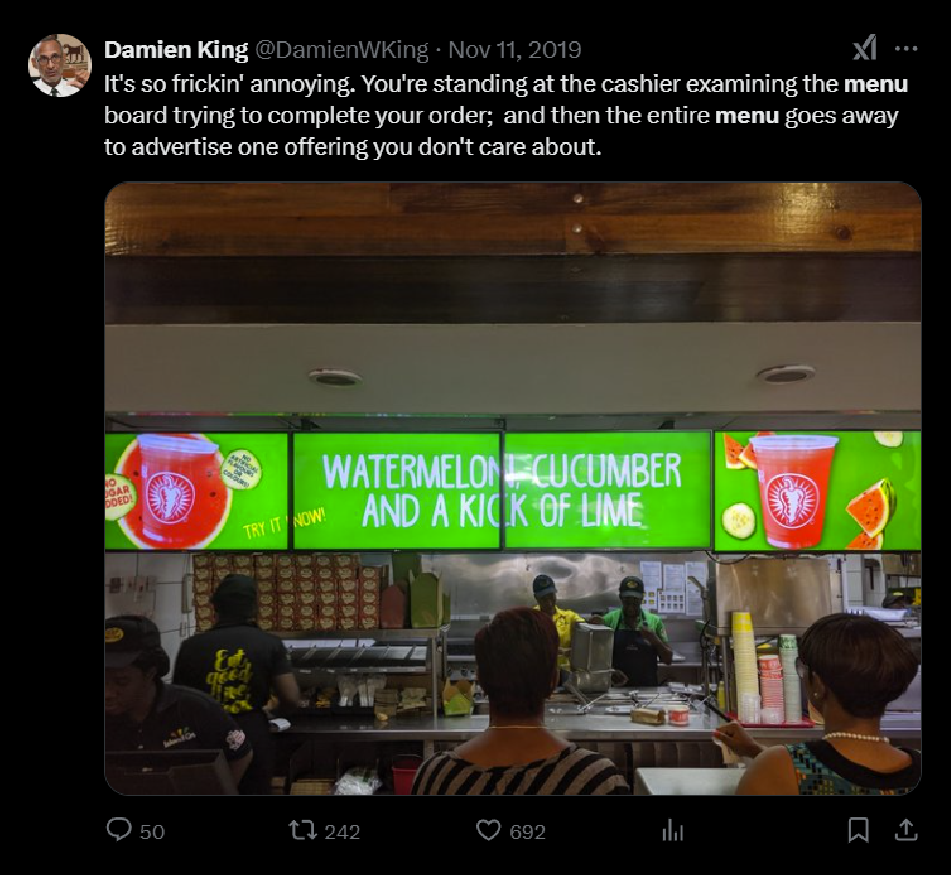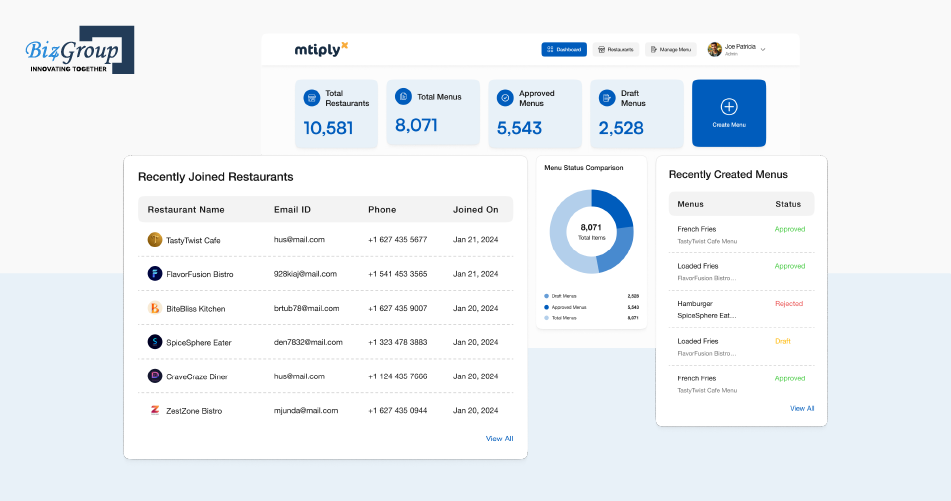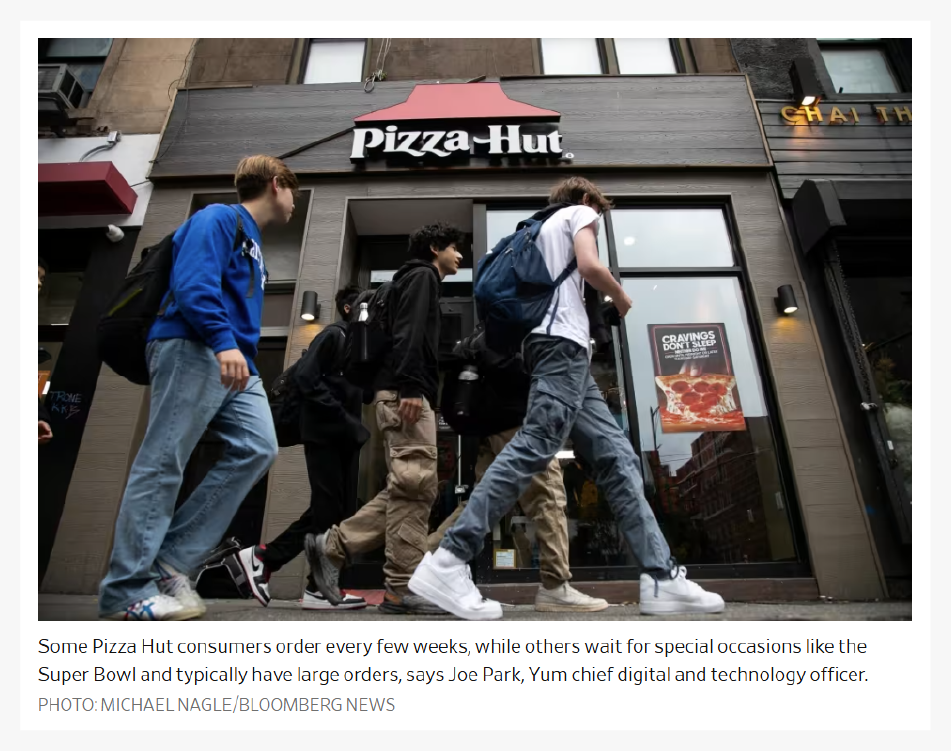Basic AI Chatbot Pricing: A simple chatbot that can answer questions about a product or service might cost around $10,000 to develop.
Read More
TL; DR

Personalized menu recommendations increase basket value – Olo reported a 10% higher average order value.

Accurate demand predictions minimize food waste through inventory optimization.

AI tailors menu options to customer preferences, driving higher satisfaction and repeat visits.

AI-powered marketing campaigns integrated with AI-based menu management system improve customer engagement and retention.
"Imagine a restaurant that anticipates your every need."
Customers’ demand prediction
Customers receive menu options tailored to their food choices,
Dietary Restrictions
External factors like weather
Avoiding costly overstock
Unexpected stockouts
Result?
Your restaurant service to customers speeds up, waste is minimized and it stands out your restaurant chain as a leader in innovation. Such a change attracts both food lovers and tech-savvy diners alike.
At Biz4Group, we have manifested this reality for one of our clients. As part of AI menu management system development, our team has built a Gen-AI powered menu generator for our client - Mtiply. By adopting this SaaS-based AI menu generation software, restaurants could see an average 30% boost in their revenue.
Today we’re going to unfold how our team actually did it. You get to learn the entire development process, along with how you can implement the same as per your requirements.

Restaurant owners managing multiple locations know how difficult it is to keep menus relevant and inventories under control. The most common issues with traditional restaurant menu management systems include:
In the US retail food industry, stockouts are estimated to cost $15 billion/year in lost sales.
Seasonal shifts and events lead to stockouts or excess inventory because of unreliable demand forecasts. This as a result leads to disappointing customers when high-demand items run out. On the other hand, over-purchasing leads to waste of perishable ingredients.
Staff manually track inventory, often resulting in data errors that lead to
Incorrect stock levels
Missed reordering opportunities
Financial losses due to overstocking/understocking
As per a report by ReFed, we can save almost 400 thousand tons of food waste annually. And AI-based restaurant management software can be the driver to this change.

Updating menus manually on multiple platforms increases the likelihood of
Missing menu items,
Outdated prices/promotions,
Frustrated customers who expect accurate information.
Customers crave tailored experiences, but static menus fail to meet these expectations, leading to missed upsell opportunities.
In a survey conducted by Bounteous x Accolite, 70% of consumers said that menu recommendations based on past purchases make them feel as if the restaurant “knows” them.

Without data-driven insights, restaurant owners often guess which items to promote or remove, affecting sales.
As per a study commissioned by Mastercard, 70% of restaurant leaders agreed on the importance of menu optimization. They think that the latter plays a crucial role in achieving their organizational goals.
So, how AI improves restaurant menu management. Let’s learn from how we at Biz4Group did it.

Our team of developers and AI experts built the restaurant menu management system with AI technology. Restaurants’ menus can be optimized based on what is running in trend, through generative AI.
Biz4Group's Approach
We started by listening. Our client wanted to customize menu options, based on the restaurant’s existing menu style. He wanted to keep his menu updated as per trending dishes in the market, for a particular cuisine. From there, we mapped out a feature-focused AI solution that aligned with their goals.
Your Guide: Start with the end in mind.
Picture this: You’re no longer scrambling to manage orders during rush hours or dumping unused ingredients at the end of each month. What do you want your AI system to achieve?
Ask yourself:
Do you want to cut costs by eliminating waste?
Are you seeking better demand forecasting during busy seasons?
Do personalized menus sound like the key to more loyal customers?
The answers to these questions shape the foundation of your system.

Biz4Group's Approach
We built key features designed to deliver results fast. This included:
Generative AI to suggest new menu items by analyzing existing data on popular ingredients/cuisines of a restaurant.
For example, AI might generate creative new dishes like "Signature Seafood Dish" based on the popularity of both Scallop and White Wine in different cuisines, for a given restaurant.
This drove immediate improvements, increasing both sales and efficiency by reducing manual efforts.
Your Guide: Identify what your system absolutely needs to succeed.
Consider your core challenges:
Do seasonal trends affect your sales? Implement demand forecasting.
Are your staff spending hours manually updating inventory? Add real-time syncing with your POS system.
Do your menus lack variety or customization? Use AI-generated recommendations to wow your guests.
Start small—focus on high-impact AI-driven menu solutions and expand over time.
Pro Tip: Choose technologies that can scale with your business.
Suggested stack:
Backend API: FastAPI (Python), Flask, or Node.js
AI Models: TensorFlow, PyTorch (for demand forecasting and personalization)
Database: PostgreSQL or MongoDB for managing inventory and order data
Cloud Infrastructure: AWS, Azure, or Google Cloud for scalability and performance
POS Integration: API-based POS systems like Toast or Square
To explore the opportunities of generative AI in retail business like running restaurant chains or so, you may have this quick read.
Biz4Group's Approach
We didn’t roll out the entire solution at once. Instead, we built a pilot version focusing on core features and tested it for a single cloud restaurant. This allowed us to gather valuable feedback, refine the system, and make improvements before expanding.
Early results? A 10% increase in average order size within two months.
Your Guide: Think of your MVP as a “proof of concept” for success.
Instead of overwhelming yourself with a full-feature rollout, focus on the essentials. Pilot your system in one or two locations, and pay close attention to:
Define the core features of your MVP – For example, AI-powered demand forecasting, real-time inventory management, or linking POS to your AI system for order and stock updates.
Select scalable technologies to support your MVP, as suggested above.
Build a prototype for one location.
Conduct a pilot run for at least 4-6 weeks.
Track the key metrics you have set for the MVP of the AI-based menu management system. Such metrics can be sales performance/inventory efficiency/customer feedback regarding menu personalization and service improvements/reduction in manual work.
Use the feedback to optimize the system.
Train your kitchen staff/pilot testing customers/managers on how to use AI in their routine tasks or while using the restaurant app during the pilot testing phase.
Testing in a small setting ensures you can address hiccups before scaling across all locations. Besides, to seek a fair idea of the approximate cost to build an MVP, you can go through this quick guide – How much does it cost to build an MVP for AI applications?
Biz4Group's Approach
Once the MVP was launched, we worked closely with the client to collect data on performance metrics. We discovered opportunities to enhance AI predictions and fine-tuned the system to meet customer and staff needs.
Your Guide: Treat your pilot test like a feedback goldmine.
Ask your team and customers for input. Track KPIs like:
How much waste reduction you’re seeing after AI-based predictions?
Whether the system saves time by automating inventory tasks.
The increase in average spend from personalized menu options.
Remember, your MVP’s success isn’t just in data—it’s in how smoothly your staff can use it and how much your customers notice the improvements.
Biz4Group's Approach
After refining the MVP, we deployed the system for all cloud restaurants. To ensure adoption, we built a Training video for the client’s team and the respective virtual restaurant owners. Here is that for your reference:
Your Guide: No system succeeds without a prepared team.
Invest in staff training to ensure your new AI system is used effectively. Break it down by role:
Kitchen staff: How to use AI alerts for inventory control.
Servers: How to explain personalized menu recommendations to customers.
Managers: How to track performance through analytics dashboards.
Biz4Group's Approach
We worked with the client to create a buzz around their AI system launch.
Pre-launch: Social media teasers introduced customers to the new, innovative dining experience.
Launch Day: A soft launch event invited influencers and loyal customers to test how the AI-powered features made a difference in the existing restaurant menu.
Post-launch: The client promoted real success stories through customer testimonials and special offers.
Your Guide: Don’t keep your new AI system a secret—celebrate it!
Launch strategies can include:
Engaging influencers to review your AI-driven personalization.
Sharing behind-the-scenes stories on how the AI improves service.
Offering limited-time promotions tied to AI recommendations.
Use our Marketing Guide to plan your launch for the AI-based menu management system.
Biz4Group's Approach
After full deployment, we continued monitoring key performance indicators (KPIs) such as sales growth and repeat customers. These insights helped the client identify opportunities to expand their business.
Your Guide: Make optimization an ongoing process.
Track KPIs that matter most to your business:
Revenue growth tied to personalized menu options.
Operational efficiency improvements through automated inventory updates.
Customer retention rates, driven by tailored experiences.
When your system proves successful, consider expanding to new locations using data-driven strategies.
Implementing an AI-based menu management system can significantly enhance various aspects of restaurant operations, leading to notable financial benefits. Let's explore these advantages through real-world examples of restaurant chain owners and restaurant technology platforms implementing AI for their clients:
AI systems analyze customer preferences and purchasing behaviors to suggest tailored menu items, encouraging additional purchases.
Case Study: Olo's smart cross-sell feature utilizes AI to recommend relevant items during the ordering process. A recent test showed that smart cross-sells accounted for a 10% higher basket value on average compared to static cross-sells.
An AI-based menu management system collects and analyzes customer data such as order history. This data can then be used for personalized marketing campaigns. AI generates tailored promotions and menu suggestions based on customer segments (e.g., loyalty members, and frequent diners), increasing the likelihood of repeat visits.
By delivering customized marketing messages and offers, AI helps in retaining customers and enhancing their dining experience. Also, to help you more, you may want to learn about the role of AI chatbots in marketing and sales.

Source – Wall Street Journal
Case Study: Yum Brands, the parent company of Taco Bell and KFC, reported that AI-driven marketing campaigns have led to increased purchases and reduced customer turnover. The company observed significant improvements in consumer engagement compared to traditional marketing methods.
AI analyzes historical sales data and external factors to predict demand accurately, optimizing inventory levels and reducing waste.
Case Study: A popular European coffee retail chain implemented ThroughPut’s AI system that provided the café with real-time insights into current customer demand and predicted near-term trends. This enabled the café to adjust its menu based on anticipated changes in customer tastes.
Also, here is a quick guide on how you can use AI for inventory management in your restaurants.
AI enhances the dining experience with personalized recommendations, streamlined QR code ordering, and increased sales through efficient service.
Case Study: Australian start-up me&u has developed an AI-powered menu management system that utilizes QR code ordering to enhance the dining experience. By analyzing customer preferences and previous orders, the system provides personalized dish and drink recommendations.
Ready to optimize your operations by implementing AI in restaurant menu planning? Whether you’re starting with an MVP or scaling across locations, Biz4Group – an AI development company provides tailored AI-powered restaurant solutions to meet your needs.
Resource Hub:
Download our Goal-Setting Template
Explore our Portfolio of AI-based menu management system
Schedule a Free Consultation today!

Automation of tasks like demand forecasting, real-time inventory tracking, and menu personalization are some examples of how AI can enhance restaurant operations. This as a result leads to reduced food waste, optimized stock levels, and faster service to customers.
The primary key features that are required to be included in an AI menu management system are:
Real-time inventory syncing with your POS system to prevent stockouts
Dynamic menu optimization to reflect market trends
AI-powered demand forecasting to predict future customer orders
Personalized menu recommendations, based on customer preferences.
You can test the success of your AI system by conducting a pilot run at one restaurant. Monitor key performance indicators like:
Reduction in food waste & stockouts
Increase in sales and order size from AI-driven recommendations
Feedback from staff and customers about system usability.
To create buzz around your AI system, use a combination of pre-launch, launch, and post-launch strategies:
Pre-Launch: Share teasers on social media and collaborate with influencers to preview your AI-powered features.
Launch Day: Host a soft launch event with live demonstrations of AI-driven features.
Post-Launch: Promote success stories through customer testimonials, special offers, and behind-the-scenes content about how AI enhances operations.
These strategies help position your restaurant as an innovator in the market.
IN YOUR BUSINESS FOR FREE
Our website require some cookies to function properly. Read our privacy policy to know more.